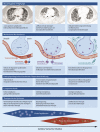[Noninvasive respiratory support and invasive ventilation in COVID‑19 : Where do we stand today?]
- PMID: 35397669
- PMCID: PMC8994638
- DOI: 10.1007/s00101-022-01114-x
[Noninvasive respiratory support and invasive ventilation in COVID‑19 : Where do we stand today?]
Erratum in
-
Erratum zu: Nichtinvasive respiratorische Unterstützung und invasive Beatmung bei COVID-19.Anaesthesiologie. 2022 Dec;71(Suppl 2):242. doi: 10.1007/s00101-022-01132-9. Anaesthesiologie. 2022. PMID: 35925197 Free PMC article. German. No abstract available.
Abstract
The controversy surrounding ventilation in coronavirus disease 2019 (COVID-19) continues. Early in the pandemic it was postulated that the high intensive care unit (ICU) mortality may have been due to too early intubation. As the pandemic progressed recommendations changed and the use of noninvasive respiratory support (NIRS) increased; however, this did not result in a clear reduction in ICU mortality. Furthermore, large studies on optimal ventilation in COVID-19 are lacking. This review article summarizes the pathophysiological basis, the current state of the science and the impact of different treatment modalities on the outcome. Potential factors that could undermine the benefits of noninvasive respiratory support are discussed. The authors attempt to provide guidance in answering the difficult question of when is the right time to intubate?
Die Kontroverse um das Thema Beatmung bei vorliegender „coronavirus disease 2019“ (COVID-19) hält an. Zu Beginn der Pandemie wurde postuliert, dass die hohe Letalität auf den Intensivstationen möglicherweise auf eine zu frühe Intubation zurückzuführen sei. Im Verlauf der Pandemie änderten sich die Empfehlungen der Fachgesellschaften, und die Häufigkeit der Anwendung von nichtinvasiver respiratorischer Unterstützung (NIRS) nahm zu. Weiterhin fehlen große Studien zur optimalen Beatmung von COVID-19-Patienten. Der vorliegende Übersichtsbeitrag fasst die pathophysiologischen Grundlagen, den aktuellen Stand der Wissenschaft und die Auswirkungen der unterschiedlichen Behandlungsmodalitäten auf das Outcome zusammen.
Keywords: Acute respiratory distress syndrome; Critical care; Invasive ventilation; Non-invasive ventilation; Prone position.
© 2022. The Author(s), under exclusive licence to Springer Medizin Verlag GmbH, ein Teil von Springer Nature.
Comment in
-
[Respiratory support in COVID-19: all in due time!].Anaesthesist. 2022 May;71(5):331-332. doi: 10.1007/s00101-022-01123-w. Epub 2022 May 4. Anaesthesist. 2022. PMID: 35507044 Free PMC article. German. No abstract available.
References
Publication types
MeSH terms
LinkOut - more resources
Full Text Sources
Medical
Research Materials




